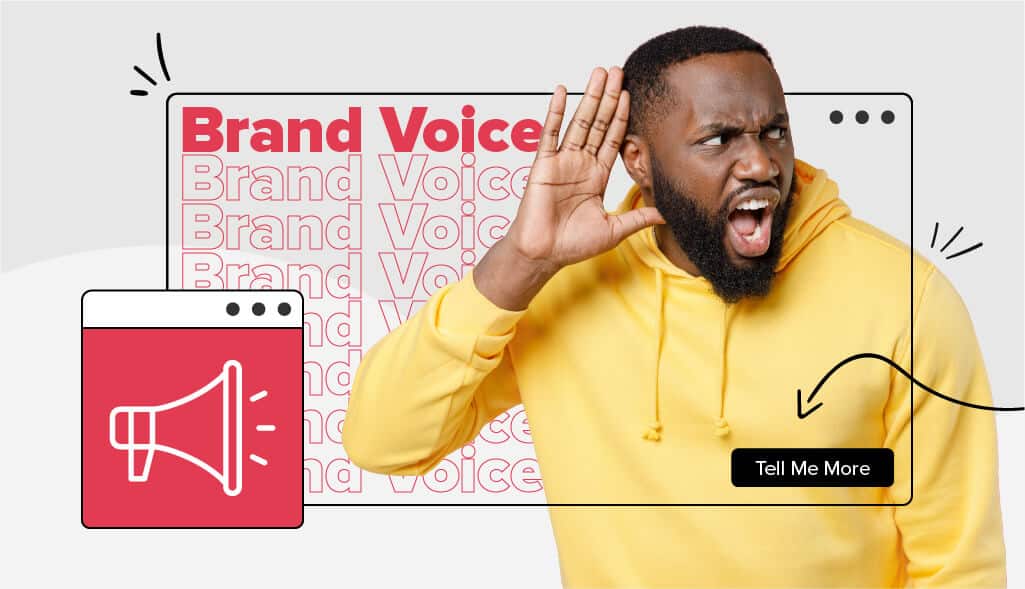
If your business suddenly lost its logo, how would your audience know how to identify you?
Hopefully, through your brand voice!
You might have heard that having a logo is a key part of branding your business, and that it’s important to build a visual identity around that logo. However, most business owners overlook an equally important aspect of branding: Creating and sticking to a unique voice.
A “brand voice” is essentially how your brand’s content sounds in people’s heads. It should embody the brand personality you’ve created for your business, and it’s the tone that seeps into all of your business’s communication, regardless if it’s on social media or through customer service.
The easiest way to define brand voice is to look at how well-known brands use it. Let’s take the product details of this belted shirt dress from online fashion retailer ASOS as an example:
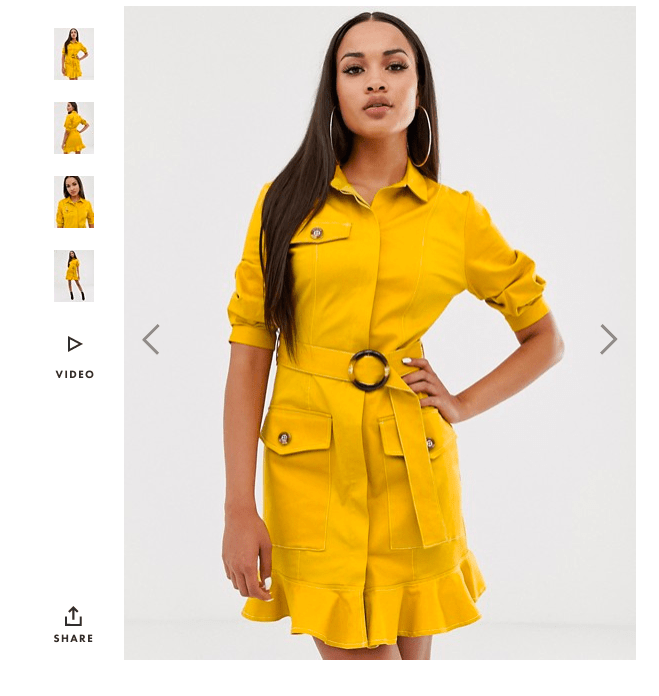
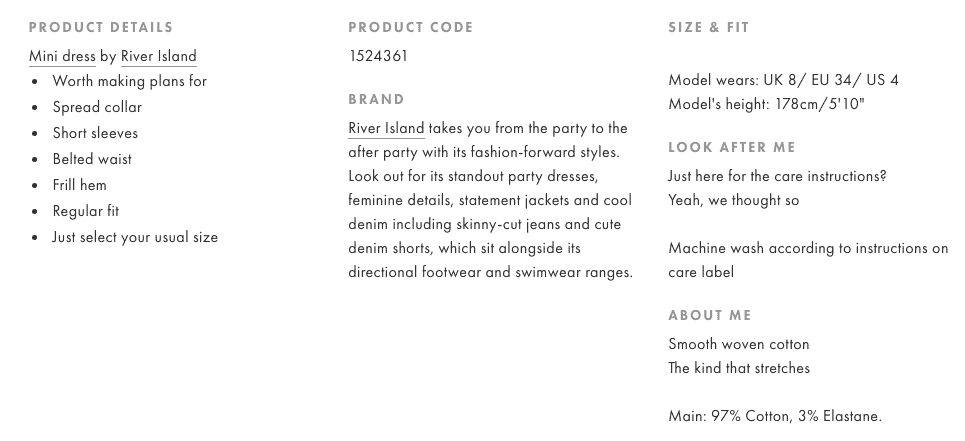
Notice how the first thing listed is “Worth making plans for”, rather than the standard “made from 20% cotton” information that most shoppers tend to ignore?
This is an easy way to show how a brand can take the most ordinary (and, let’s face it, boring) content and use their brand voice – in the case of ASOS, a voice that’s clever, catchy, and exciting – to appeal to their audience.
But in addition to the entertainment factor, using a consistent brand voice can actually help you retain customers and boost your sales! In fact, studies have shown that consistently presenting a brand can increase revenue by 33%.
That’s because the more consistent your brand is, the more likely your audience will be to remember your brand – helping them feel like they can trust you to deliver a specific, positive experience.
Not only that, but 61% of people are more likely to buy from brands that they feel deliver unique content. You may not be able to control what you say online – after all, if you’re a real estate agent, you’ll probably focus most of your online communication around real-estate-related topics – but what you can control is how you say it.
That’s a big part of what will differentiate your brand from competitors, and again, help you stay relevant in the minds of your audience.
Like we mentioned, your voice is a reflection of your brand’s overall personality; it’s consistent and unchanging.
Your brand voice should be:
– Distinct. Creating a brand voice shouldn’t be about becoming the next Apple or the new Facebook; it’s about becoming the first you, and bringing a new voice to the table.
– Identifiable. As in, can your audience read a piece of content you wrote and automatically know it came from your brand? The answer should be a definite yes.
– Complementary to the rest of your brand identity. All of the elements that make up your brand identity should be cohesive with one another, so that together, they paint an entire picture of “who” your brand is.
–Consistent. Whether you’re posting an interesting article on your Facebook page or are responding to a customer’s email, your brand voice should be at the front and center of your content.
However, where your brand voice is consistent, your tone can change depending on where it’s being used. In other words, your brand voice encompasses the general things that you say, while your tone informs how you say it.
The way you respond to a comment on social media will probably have a lighter tone than if you’re responding to an angry customer who complained via email; similarly, a product announcement would pack more excitement than a message about your opening hours.
Now that you understand why brand voice is important and the general “rules” for using one that works, let’s dive in and create yours! You can check out this video to get started, or continue reading for 7 steps to help craft your voice:
Here’s a list of steps that will help you come up with a voice that best represents your business.
As with determining any part of your brand identity, you’ll need to keep your original mission statement in mind when creating your brand voice.
Remind yourself: Why did you start your company? What are the values sitting at the core of everything you do?
Let’s take a look at the Alzheimer’s Association mission statement as an example of what this means:
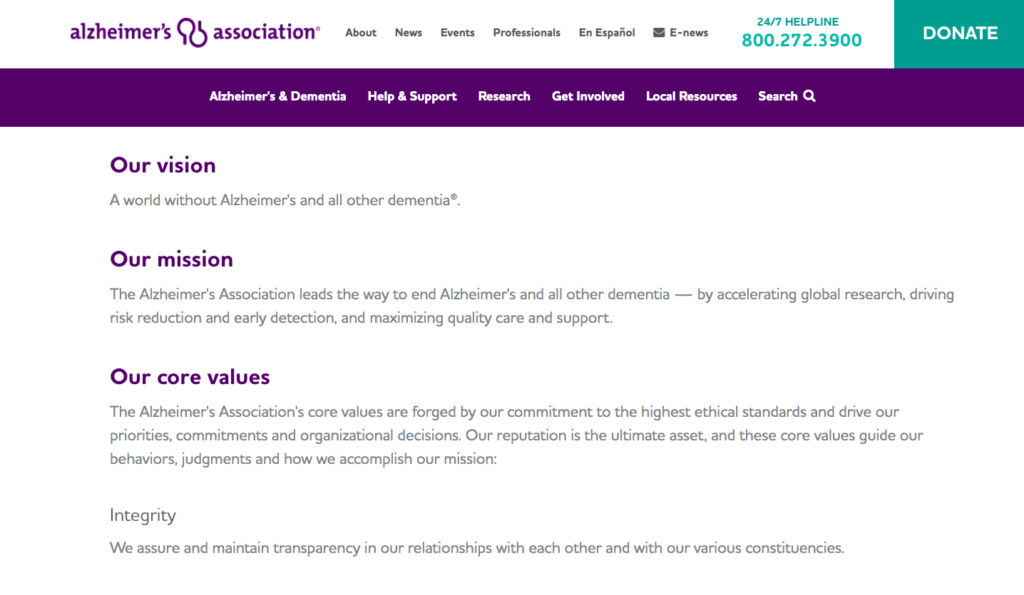
Their mission is to “end Alzheimer’s and all other dementia – by accelerating global research, driving risk reduction and early detection, and maximising quality care and support.” Behind this mission lies integrity, inclusiveness, diversity, commitment to excellence, etc.
Your brand voice is going to constantly emphasize and reinforce specific traits about your business in the minds of your audience, so you’ll want to make sure to be proactive about which traits these are. In other words, the way you speak to your audience should be easily connected back to your core values, which all stem from your mission statement.
To come up with these traits for your own business, you can go through the exercises on this template:
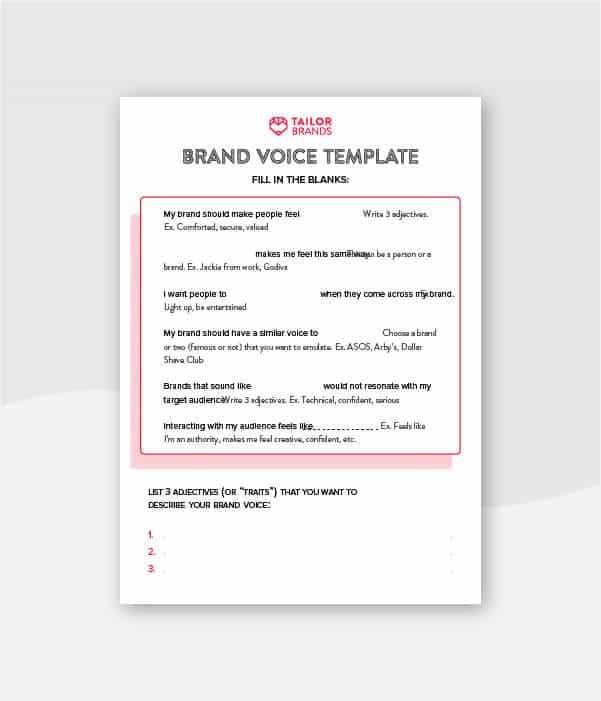
You should be able to have an idea of what your brand voice should sound like by the end.
Now, how do you start putting your brand voice into action?
f you’ve already created content for your brand – whether that’s a single ad banner, a slew of posts on social media, or an entire blog – then this is the time to evaluate what you’ve put out into the world. (And, if you’ve just launched but haven’t yet created any content, don’t worry! You can go ahead and skip this step.)
Make sure to look at your:
Are there common themes in the language, or certain words you notice that keep appearing across posts? Or, do some posts read as serious and heavy, where others seem silly and light? Note where there are similarities and what the discrepancies are.
Here’s a landing page by Spanx, the clothing brand, inviting customers to refer their friends and get a discount:
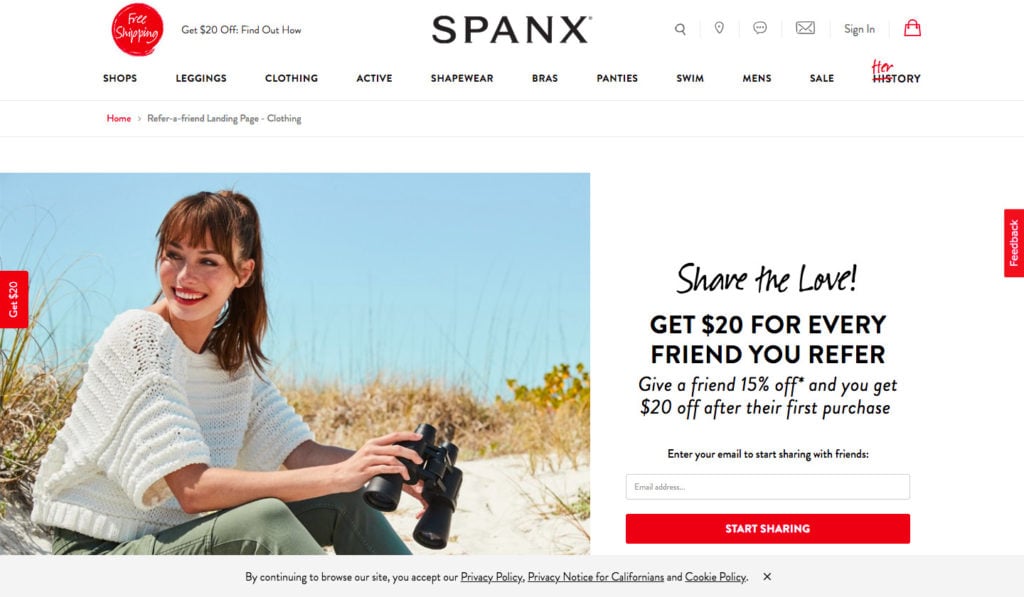
Notice how the first thing they say is “Share the love”? That playful, excited energy is echoed in their Instagram posts (“What do long weekends and Spanx denim have in common? Everyone loves them!”):
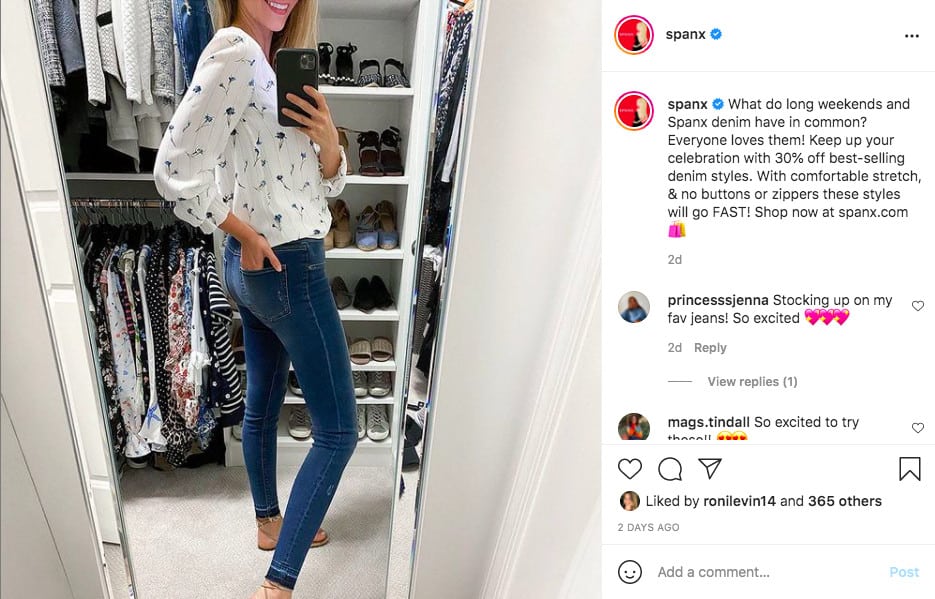
Once you go through your existing content, analyze its language and tone in relationship to its performance. Consider a piece of content as performing “well” if it met your goals for that content at the time you posted it, whether those goals were shares, clicks, likes, comments, or plain old views.
(If you didn’t have goals for creating content before, once again – don’t worry! This is a great time to start thinking about your content as a branding tool that does work for you.)
Evaluate which of your posts had the best engagement, and which left a lot to be desired. As you’re wading through content, try to see if there are commonalities between the posts that have resonated with your audience, and vice versa for posts they didn’t receive well.
How do your competitors talk to their (your) audience? What’s their tone of voice; do they even have one? If you read through their blog content and/or social media posts and start to feel like you can “envision” who the brand is after 10 minutes, chances are that they are using some sort of defined brand voice.
Now, ask yourself if their brand voice(s) matches your industry. Should you take a similar approach to talking with your audience, or is it an inappropriate match to your own brand mission? You can scope out the comments on their social media pages to get an idea of whether their voice is landing with their audience or falling flat.
Ideally, you won’t be creating a brand voice that’s identical to your competitors’, as this will neither set your brand apart from theirs nor give your brand a unique edge. However, it’s important to get a sense of what’s out there – both your competitors’ failures and certainly their successes – so you can think about new ways to address your audience (and if nothing else, then for plain old inspiration).
Who is your target audience – are they young? Married? Preoccupied with social issues, or worried about their finances?
Or, if you’ve already gone live with your business and have an audience that knows you, this would be a good time to get an idea of what they think of you. Like you did in your content audit, it’s important to evaluate the parts of your brand they connect with and the parts of your brand personality they could do without.
The best way to find out? Ask them!
Create a poll on social media, send one out to your email list, or check for comments on your blog. Try to ask things like:
– Describe our brand in three words.
– If our brand were a person, who would it be?
– Do you think our tone fits with our product/service?
You can turn this into a contest, or offer a discount on a product of yours for the first 50 people to respond.
Once you get responses, note how much of what they’ve said about your brand overlaps with what you’ve said about yourself. If you’re both in the same ballpark, then you know your brand voice is already on the right track!
Note that your audience’s ideal brand voice might not be the voice you would expect them to want to hear.
A game company that created a product full of sass and snark, Cards Against Humanity prides themselves on being offensive. But, rather than alienating their customer base, their chutzpah is exactly what attracts people to their brand. People know that they can rely on the brand to consistently toe the line (frequently crossing into the realm of the politically incorrect), promising a good joke in the process.
What’s important to note is that CAH commits to their voice, no matter if they’re running a holiday campaign or putting out a new product. They even played on their brand personality to stage their own form of political protest, rallying people to join their cause through sarcasm and satire.

As mentioned above, your brand voice is an important component of your overall brand personality.
Describe your brand’s personality, using concrete adjectives and fleshed-out details. What does your brand sound like when it speaks? What vibe does its design give off?
You may want to talk this out with another person, or write everything down on paper without thinking too much about it. Include details like what your brand would be like at a party, and what it would never, ever do in public.
When you have this all written down, you’re ready to come up with 3 adjectives that describe your brand. Choose words that encompass all of the main traits you think are important to convey your personality. For example: “Kayla’s Closet is trendy, bold, and always full of sass.”
Don’t force it; try to choose traits that are in line with what your brand offers and reinforce your mission statement. Having an authentic brand voice is one of the main ways to grip your audience, so don’t worry if you end up with traits that are slightly different than you expected.
Then, you’ll want to “unpack” each trait. Include a description of the trait, and specific do’s and don’t statements for how you’ll use it. (We’ll talk more about this in the sections to come.) You can use this template to help you come up with these descriptions:
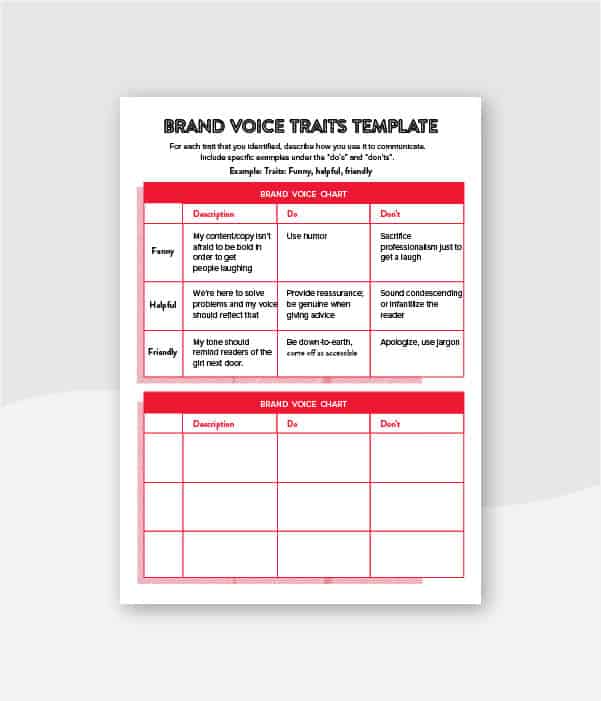
You’ve got your adjectives down; now, try your brand voice on for size – on the internet.
Write a sample blog post using your new tone, and ask a friend, partner, or someone who knows your business well what they think. If you get the green light, try sending out an email to a group of beta readers (i.e. friends and family) to see if they like what you’re putting out or if they immediately tell you to turn the bus around.
Also, evaluate how your brand voice works with other elements of your brand. Is your tone consistent with the rest of your visual identity? What kind of message do your logo and colors send together with your voice? Make sure you’re getting “consistent” rather than “conflicting;” you want your brand to work harmoniously together, not to put people off or confuse them with what you’re trying to say.
When you feel like you’ve got it down, start posting on your social media channels to see how your audience reacts. You may find that, down the line, your audience ends up being different than you initially thought, and they might respond better to an adapted version of your voice.
Razor company Gillette took a stab at this in the past couple of years, rebranding through a coming-out video aimed at fighting against toxic masculinity.
They played off of their own tagline, “The Best a Man Can Get” – which had been their mantra for the last 30 years – and challenged their audience to instead strive for “The Best a Man Can Be.”
To emphasize their commitment to social issues, Gillete created a website and social media channels that all incorporate their new-and-improved, sincere, compassionate and morally-concerned language.
The response to this rebrand was controversial, which just goes to show that it’s important to gear your voice to be in line with your ideal audience, whether that means adapting with the times when they do or sticking to your guns if you know it’s what they want.
This brings us to:
Consistency is your brand’s number one key to success – in all aspects of branding, but especially when it comes to your brand voice. Any content that you publish from here on out needs to be in line with your brand voice, so that your audience can come to get to know it, love it, and learn to rely on your brand to deliver what they expect.
Dollar Shave Club – another razor brand – is a great example of a brand that does just this. The CEO had a hunch that razors could be entertaining, and he used humor to create a launch video meant to be as funny as it was advertorial. Not only did this video go viral (with millions of views in the first three months), but it also set the tone for the Dollar Shave Club brand forever on.
Video is a great way to connect with your audience, and Dollar Shave used the language they knew their audience – young, regular men in need of a shave – could relate to. And, since then, all of the shareable digital content the brand creates has remained in that same relatable, funny voice. Look no further than their entire Instagram feed if you want a laugh:
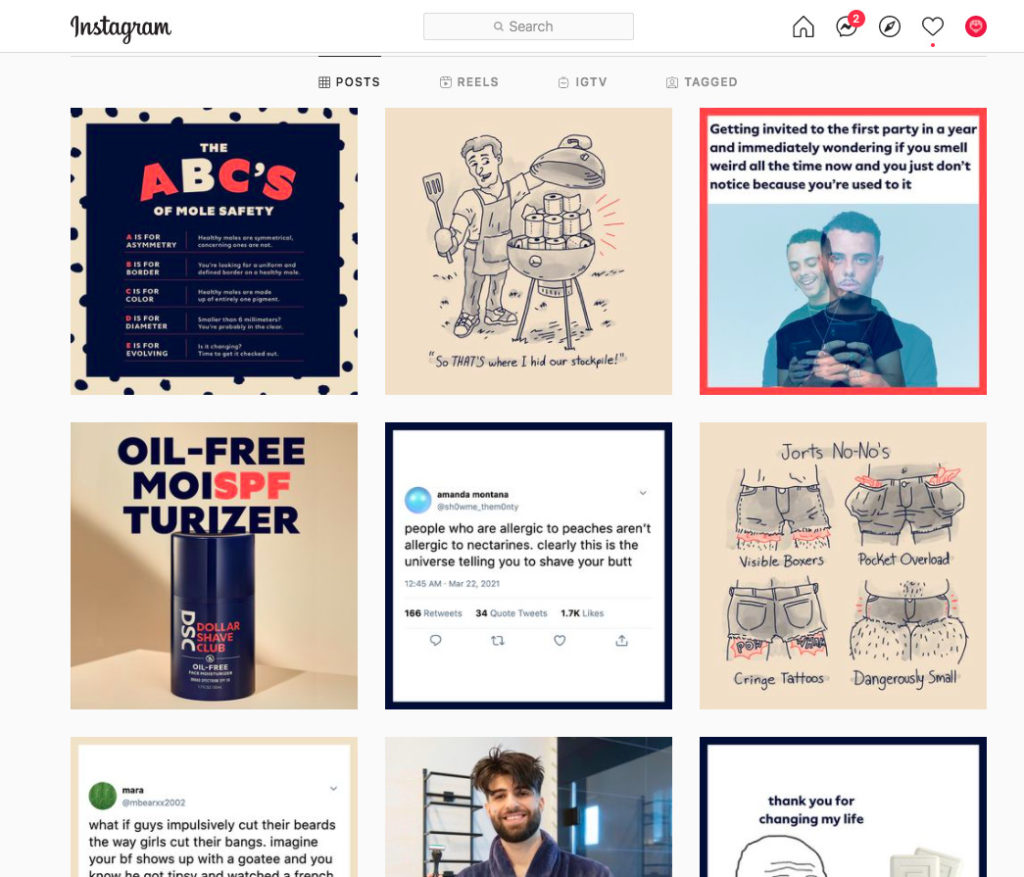
To ensure this consistency – whether you’re sitting in the solo car on the entrepreneurial train or you’re conducting a whole crew -it’s important to set guidelines that explain how your brand voice is allowed to sound in different contexts.
Outline what your voice is and what it isn’t, but be much more specific than you were in Step 4. Use concrete examples, such as “We love dad jokes, but we never make puns,” so that any content creators you may bring on board don’t have to wonder what kind of “funny” is acceptable. (Again, let’s circle back to Cards Against Humanity; their version of humor is a far cry from the tame jokes of any other brand in comparison.)
Write out a few example sentences that are appropriate for your brand to say, and examples of what not to say; the more specific you can be, the better. In the long run, these guidelines will help your brand stay on-message regardless of the context or the platform through which you’re communicating.
There are a hundred ways to tell a good story, but choosing and developing your brand voice means you’ve picked the best way for your audience! Once you craft the right voice for your business, you’ll find it easier to create content that resonates with your audience and keeps them coming back for more.
The information provided on this page is for information, educational, and/or editorial purposes only. It is not intended to indicate any affiliation between Tailor Brands and any other brand or logo identified on this page.
Products
Resources
@2024 Copyright Tailor Brands